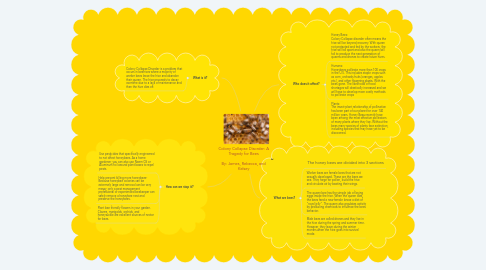Colony Collapse Disorder: A Tragedy for Bees By: James, Rebecca, and Kelsey
von Rebecca Michalak

1. How can we stop it?
1.1. Use pesticides that specifically engineered to not affect honeybees. As a home gardener, you can also use Neem Oil or Aluminum foil around plant bases to repel pests.
1.2. Help prevent killing more honeybees- Because honeybee colonies can be extremely large and removal can be very messy, only a pest management professional or experienced beekeeper can safely remove a honeybee nest and preserve the honeybees.
1.3. Plant bee friendly flowers in your garden. Clovers, marigolds, orchids, and honeysuckle are excellent sources of nectar for bees.
2. What is it?
2.1. Colony Collapse Disorder is a problem that occurs in beehives where a majority of worker bees leave the hive and abandon their queen. The hive proceeds to decay overtime due to a lack of maintenance and then the hive dies off.
3. Who does it affect?
3.1. Honey Bees: Colony Collapse disorder often means the hive will be beyond recovery. With queen not protected and fed by the workers, the hive will fall apart and also the queen will fail to produce the next generation of queens and drones to create future hives.
3.2. Humans: Honeybees pollinate more than 100 crops in the U.S. This includes staple crops such as corn, orchards fruits (oranges, apples etc.), and other flowering plants. With the bees gone. The likelihood of food shortages will drastically increased and we will have to develop more costly methods to pollinate crops
3.3. Plants: The insect-plant relationship of pollination has been part of our planet for over 140 million years. Honey Bees recently have been among the most effective pollinators of many plants where they live. Without the bees many species of plants face extinction, including species that may have yet to be discovered.
4. What are bees?
4.1. The honey bees are divided into 3 sections
4.2. Worker bees are female bees that are not sexually developed. These are the bees we see. They forge for pollen, build the hive and circulate air by beating their wings.
4.3. The queen bee has the simple job of laying eggs inside the hive. When the queen dies, the bees feed a new female larvae a diet of "royal jelly". The queen also regulates activity by producing chemicals to influence the bees behavior.
4.4. Male bees are called drones and they live in the hive during the spring and summer time. However, they leave during the winter months when the hive goes into survival mode.


